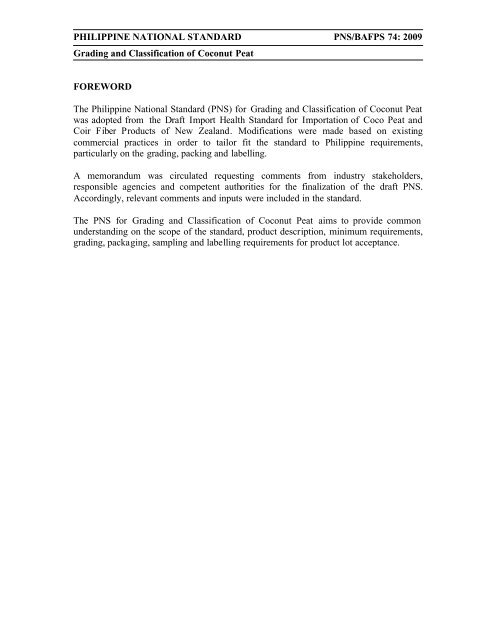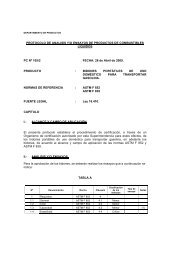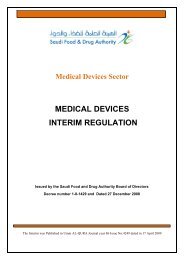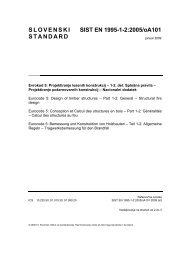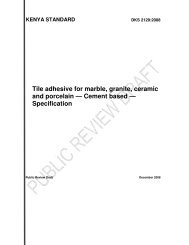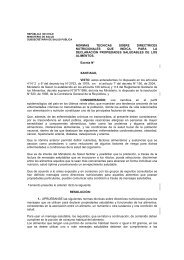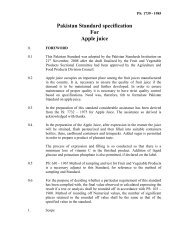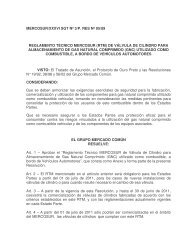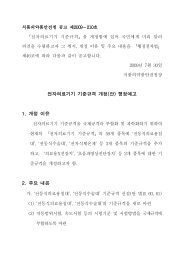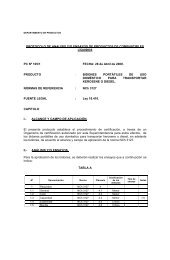Grading and Classification of Coconut Peat
Grading and Classification of Coconut Peat
Grading and Classification of Coconut Peat
You also want an ePaper? Increase the reach of your titles
YUMPU automatically turns print PDFs into web optimized ePapers that Google loves.
PHILIPPINE NATIONAL STANDARD PNS/BAFPS 74: 2009<br />
<strong>Grading</strong> <strong>and</strong> <strong>Classification</strong> <strong>of</strong> <strong>Coconut</strong> <strong>Peat</strong><br />
FOREWORD<br />
The Philippine National St<strong>and</strong>ard (PNS) for <strong>Grading</strong> <strong>and</strong> <strong>Classification</strong> <strong>of</strong> <strong>Coconut</strong> <strong>Peat</strong><br />
was adopted from the Draft Import Health St<strong>and</strong>ard for Importation <strong>of</strong> Coco <strong>Peat</strong> <strong>and</strong><br />
Coir Fiber Products <strong>of</strong> New Zeal<strong>and</strong>. Modifications were made based on existing<br />
commercial practices in order to tailor fit the st<strong>and</strong>ard to Philippine requirements,<br />
particularly on the grading, packing <strong>and</strong> labelling.<br />
A memor<strong>and</strong>um was circulated requesting comments from industry stakeholders,<br />
responsible agencies <strong>and</strong> competent authorities for the finalization <strong>of</strong> the draft PNS.<br />
Accordingly, relevant comments <strong>and</strong> inputs were included in the st<strong>and</strong>ard.<br />
The PNS for <strong>Grading</strong> <strong>and</strong> <strong>Classification</strong> <strong>of</strong> <strong>Coconut</strong> <strong>Peat</strong> aims to provide common<br />
underst<strong>and</strong>ing on the scope <strong>of</strong> the st<strong>and</strong>ard, product description, minimum requirements,<br />
grading, packaging, sampling <strong>and</strong> labelling requirements for product lot acceptance.
PHILIPPINE NATIONAL STANDARD PNS/BAFPS 74: 2009<br />
<strong>Grading</strong> <strong>and</strong> <strong>Classification</strong> <strong>of</strong> <strong>Coconut</strong> <strong>Peat</strong><br />
1. SCOPE<br />
This st<strong>and</strong>ard specifies requirements <strong>and</strong> establishes a system <strong>of</strong> grading <strong>and</strong><br />
classifying coco peat, a product from extraction <strong>of</strong> fiber from coconut husks. This<br />
st<strong>and</strong>ard covers coco peat intended to be used as a growing medium in various<br />
grades <strong>and</strong> finished products for horticultural/agricultural use. This excludes coco<br />
peat used for animal bedding.<br />
2. REFERENCES<br />
The titles <strong>of</strong> the st<strong>and</strong>ards publications referred to in this st<strong>and</strong>ard are listed on the<br />
inside back cover.<br />
3. DEFINITIONS<br />
3.1 bale<br />
Refers to the volume <strong>and</strong> manner <strong>of</strong> packing the coco peat traded commercially<br />
3.2 coco dust<br />
A product produced when coconut husks are processed for the extraction <strong>of</strong> coir.<br />
This also refers to coir dust.<br />
3.3 coco peat<br />
Decomposed <strong>and</strong> processed coco dust.<br />
3.4 breakout volume<br />
The final volume <strong>of</strong> coco peat when fully unpacked, decompressed <strong>and</strong><br />
rehydrated<br />
3.5 contamination<br />
Unwanted presence in a commodity, storage place, conveyance or container, <strong>of</strong><br />
any material (including a regulated organism) that may pose a biosecurity risk.<br />
3.6 foreign matter<br />
Shall include, but not limited to dust, plastic, stone which are extraneous<br />
3.7 grade<br />
Shall refer to the designation <strong>of</strong> coco peat quality according to the established<br />
government st<strong>and</strong>ard<br />
3.8 pest<br />
Any species, strain or biotype <strong>of</strong> plant, animal or pathogenic agent injurious to<br />
plants or plant products [FAO, 1990; revised FAO, 1995; IPPC, 1997]
PHILIPPINE NATIONAL STANDARD PNS/BAFPS 74: 2009<br />
<strong>Grading</strong> <strong>and</strong> <strong>Classification</strong> <strong>of</strong> <strong>Coconut</strong> <strong>Peat</strong><br />
3.9 treatment<br />
Official procedure for the killing, inactivation or removal <strong>of</strong> pests, or for<br />
rendering pests infertile or for devitalization [FAO, 1990, revised FAO, 1995;<br />
ISPM No 15, 2002; ISPM No 18, 2003; ICPM 2005]<br />
4. MINIMUM REQUIREMENTS<br />
• Coco peat must be kept clean <strong>and</strong> free <strong>of</strong> seeds, pests, soil, animal material<br />
<strong>and</strong> any other contamination.<br />
• Coco peat processing areas must be free from loose animals such as chicken,<br />
dogs, pasture animals <strong>and</strong> pets which may excrete manure to the coco peat<br />
material.<br />
• Coco peat must absolutely be free from salmonella <strong>and</strong> E. coli bacteria<br />
• No coco peat is to be produced from the traditional method <strong>of</strong> retting husks in<br />
open troughs or ponds.<br />
• Washing or rinsing <strong>of</strong> coco peat, chips or crush must be carried out with bore<br />
clean water with EC <strong>of</strong> not more than 0.5mS/cm <strong>and</strong>/or rain water (direct<br />
rainfall), pond or dam water free from impurities.<br />
• Coco peat drying areas must be buffered underneath from contact with soil.<br />
• A weed free buffer zone <strong>of</strong> 3 meters must be maintained around the coco peat<br />
drying areas unless concrete walls are built on the perimeter <strong>of</strong> concrete pads.<br />
5. GRADING<br />
There shall be six (6) types <strong>of</strong> grading system for coco peat:<br />
Grade A:<br />
Fine Special Grade<br />
Coco peat sieved finer than 5mm mesh<br />
At least 6 months old<br />
Washed/leached<br />
pH : 5.5 to 6.5<br />
EC 1 (1:5 test): Below 0.5mS/cm<br />
Moisture Content: = 20%<br />
Mostly used for seed raising substrates <strong>and</strong> green house hydroponics growing <strong>and</strong><br />
salt sensitive plants <strong>and</strong> horticultural potting mixes.<br />
1 Electrical Conductivity expressed as microSiemens per centimeter
PHILIPPINE NATIONAL STANDARD PNS/BAFPS 74: 2009<br />
<strong>Grading</strong> <strong>and</strong> <strong>Classification</strong> <strong>of</strong> <strong>Coconut</strong> <strong>Peat</strong><br />
Grade B: Fine St<strong>and</strong>ard Grade<br />
Coco peat sieved in 5mm mesh<br />
At least 6 months old<br />
Washed/leached<br />
EC(1:5 test): Below 1.0mS/cm<br />
pH : 5.5 to 6.5<br />
Moisture Content: = 25%<br />
Mostly used for seed raising substrates, mushroom grow medium-mix, golf<br />
courses, green soil medium mix <strong>and</strong> special potting mixes<br />
Grade C: St<strong>and</strong>ard Grade<br />
Unsieved Cocopeat with approx. 10-15% short fibers<br />
At least 3 months old<br />
Washed/leached<br />
EC(1:5 test): Below 1.0mS/cm<br />
pH : 5.5 to 6.5<br />
Moisture Content: = 25%<br />
Mostly used for export for potting mixes, hydroponics <strong>and</strong> soil conditioning<br />
Grade D: Partially Dried Regular Grade<br />
Unsieved Cocopeat with approx. 10-15% short fibers<br />
At least 3 months old<br />
Unwashed/unleached<br />
EC(1:5 test): Below 2.0mS/cm<br />
pH : 5.5 to 6.5<br />
Moisture Content: = 30%<br />
In its pure state, mostly used for direct application for soil conditioning, increase<br />
<strong>of</strong> organic matter content in upl<strong>and</strong> crops, for moisture retention purposes for turf <strong>and</strong><br />
potting in nurseries;<br />
Grade E: Regular Grade<br />
Unsieved Cocopeat with approx. 10-15% short fibers<br />
At least 3 months old<br />
Unwashed/unleached<br />
EC(1:5 test): Below 2.0mS/cm<br />
pH : 5.5 to 6.5<br />
Moisture Content: = 60%
PHILIPPINE NATIONAL STANDARD PNS/BAFPS 74: 2009<br />
<strong>Grading</strong> <strong>and</strong> <strong>Classification</strong> <strong>of</strong> <strong>Coconut</strong> <strong>Peat</strong><br />
In its pure state, mostly used for direct application for soil conditioning, increase<br />
<strong>of</strong> organic matter content in upl<strong>and</strong> crops, for moisture retention purposes for turf <strong>and</strong><br />
potting in nurseries;<br />
Grade F: Fresh Coco Dust<br />
Undried<br />
Less than 3 months old<br />
EC (1:5 test): Below 2.5mS/cm<br />
pH 5.5-6.5<br />
Moisture Content: = 60%<br />
In its natural state, mostly used for direct application for plants with high salt<br />
tolerance/high chloride requirement.<br />
6. PACKAGING STANDARDS<br />
There shall be four (4) types <strong>of</strong> packaging for coco peat:<br />
A. Coco <strong>Peat</strong> Brick (650 gm)<br />
Dimension : 20X10X5 cm (+/- 2cm)<br />
Unit Weight : 650 gm<br />
Expansion : Above 8 liters<br />
Compression : 7:1<br />
B. Coco <strong>Peat</strong> Block (5 kg)<br />
Dimension : 30X30X13 cm (+/- 2cm)<br />
Unit Weight : 5 Kg<br />
Expansion : 70 to 80 liters<br />
Compression : 5:1<br />
C. Coco <strong>Peat</strong> Bale (25 kg)<br />
Dimension : 80X40X33 cm (+/- 2cm)<br />
Unit Weight : 25 kg<br />
Expansion : Above 250 liters<br />
Compression : 2:1<br />
Packing: 3mils Polyethylene (PE) opaque white bag<br />
D. Uncompressed coco peat (bagged)<br />
60 liter PE bag with minimum breakout volume <strong>of</strong> 70 liters
PHILIPPINE NATIONAL STANDARD PNS/BAFPS 74: 2009<br />
<strong>Grading</strong> <strong>and</strong> <strong>Classification</strong> <strong>of</strong> <strong>Coconut</strong> <strong>Peat</strong><br />
7. SAMPLING<br />
Coco peats will be r<strong>and</strong>omly sampled at the following rates (for a full 40-ft<br />
container load:<br />
Product<br />
No. <strong>of</strong> Units<br />
Bricks 585<br />
Blocks 50<br />
Bales 4<br />
Uncompressed coco peat<br />
(bagged)<br />
Use sampling plan for coir<br />
products<br />
Parameters <strong>and</strong> methods <strong>of</strong> analysis for coco peat are found in Annex 1.<br />
8. LABELLING<br />
The following shall be printed on the PE Plastic packaging <strong>of</strong> the bale or the<br />
package (optional):<br />
8.1 The words “PRODUCT OF THE PHILIPPINES”;<br />
8.2 The name <strong>of</strong> the company;<br />
8.3 The name <strong>of</strong> the municipality or city where the establishment is located;<br />
8.4 The initial <strong>of</strong> the station, the registered mark <strong>of</strong> the establishment, <strong>and</strong> the<br />
letter designation <strong>of</strong> the grade, the three (3) forming one line separated from<br />
each other by bars; <strong>and</strong><br />
8.5 The establishment number <strong>and</strong> lot number, the district <strong>of</strong> production <strong>and</strong> the<br />
date <strong>of</strong> pressing, the three (3) forming one line separated by bars.<br />
9. INSPECTION<br />
The Philippine <strong>Coconut</strong> Authority (PCA) will grade, classify <strong>and</strong> inspect coco<br />
peat to check for the presence <strong>of</strong> pests signs or symptoms, soil, seeds or any other<br />
detectable contaminants. For domestic movement <strong>of</strong> coco peat, PCA shall issue<br />
certificate <strong>of</strong> origin <strong>and</strong> permit to transport prior to issuance <strong>of</strong> quarantine<br />
certificate <strong>of</strong> DA Regional Field Units – Plant Quarantine Service. Accordingly,<br />
PCA shall issue commodity clearance for all coco peat intended for export. The<br />
commodity clearance shall be a pre-requisite to issuance <strong>of</strong> phytosanitary<br />
certificate by the Bureau <strong>of</strong> Plant Industry.<br />
PCA can tap the services <strong>of</strong> its recognized laboratories for analysis subject to<br />
agency rules <strong>and</strong> regulations.
PHILIPPINE NATIONAL STANDARD PNS/BAFPS 74: 2009<br />
<strong>Grading</strong> <strong>and</strong> <strong>Classification</strong> <strong>of</strong> <strong>Coconut</strong> <strong>Peat</strong><br />
10. COMPLIANCE AND SPECIFICATION<br />
When found to comply with the requirements specified in this Philippine St<strong>and</strong>ard<br />
Specification, the lot, the batch, or the consignment from which the samples have<br />
been drawn, shall be deemed to comply with the Philippine National St<strong>and</strong>ard<br />
Specification.<br />
BAFPS shall monitor the implementation <strong>and</strong> compliance to this set <strong>of</strong> st<strong>and</strong>ards.<br />
REFERENCES:<br />
Biosecurity New Zeal<strong>and</strong>. (2008). Draft Import Health St<strong>and</strong>ard for Importation <strong>of</strong> Coco<br />
<strong>Peat</strong> <strong>and</strong> Coir Fibre Products.<br />
Evans, M. R. <strong>and</strong> Stamps, R.H. (undated). Development <strong>of</strong> Philippine Coir Dust as A<br />
Productive Substrate for the Horticultural Market (A Final Report), Manila,<br />
Philippines. 46pp<br />
Fiber Industry Development Authority (1999). Revised Administrative Order No.1,<br />
Chapter 3: Baling, Tagging, Marking <strong>and</strong> Inspection <strong>of</strong> Fibers.
PHILIPPINE NATIONAL STANDARD PNS/BAFPS 74: 2009<br />
<strong>Grading</strong> <strong>and</strong> <strong>Classification</strong> <strong>of</strong> <strong>Coconut</strong> <strong>Peat</strong><br />
ANNEX 1: Method <strong>of</strong> Analysis for Coco <strong>Peat</strong><br />
Parameters<br />
Method <strong>of</strong> Analysis<br />
1. E. Coli. Bacteriological Analytical Manual<br />
2. Salmonella Bacteriological Analytical Manual<br />
3. Moisture Content Air Oven @ 105 o C<br />
4. pH Potentiometric (1:5 test)
PHILIPPINE NATIONAL STANDARD PNS/BAFPS 74: 2009<br />
<strong>Grading</strong> <strong>and</strong> <strong>Classification</strong> <strong>of</strong> <strong>Coconut</strong> <strong>Peat</strong><br />
Technical Working Group for the Development <strong>of</strong> Philippine<br />
National St<strong>and</strong>ard on the <strong>Grading</strong> <strong>and</strong> <strong>Classification</strong><br />
<strong>of</strong> <strong>Coconut</strong> <strong>Peat</strong><br />
Chairman<br />
Gilberto F. Layese<br />
Director<br />
Bureau <strong>of</strong> Agriculture <strong>and</strong> Fisheries<br />
Product St<strong>and</strong>ards<br />
Co-Chair<br />
Carlos B. Carpio<br />
Deputy Administrator for Research,<br />
Development <strong>and</strong> Extension<br />
Philippine <strong>Coconut</strong> Authority<br />
Members<br />
Severino S. Magat, Ph.D<br />
Manager<br />
Agricultural Research Management Department<br />
Philippine <strong>Coconut</strong> Authority<br />
Elizar M. Montemayor<br />
Supervising Science Research Specialist<br />
Product Development Department<br />
Philippine <strong>Coconut</strong> Authority<br />
Loreta C. Dulce<br />
Senior Agriculturist<br />
Bureau <strong>of</strong> Plant Industry<br />
Chalito P. Dizon<br />
OIC-Manager<br />
Trade Management <strong>and</strong><br />
Accreditation Department <strong>and</strong><br />
Concurrently Division Chief,<br />
Market Regulation Division<br />
Philippine <strong>Coconut</strong> Authority<br />
Rodolfo N. Panganiban<br />
Senior Science Research Specialist<br />
Bureau <strong>of</strong> Agriculture <strong>and</strong> Fisheries<br />
Product St<strong>and</strong>ards<br />
Special Participation <strong>of</strong>:<br />
Justiniano Arbuleda<br />
Juboken Enterprises<br />
Secretariat:<br />
Ibrahim Racmat<br />
Science Research Specialist II<br />
Bureau <strong>of</strong> Agriculture <strong>and</strong> Fisheries<br />
Product St<strong>and</strong>ards<br />
Marvin Apduhan<br />
Planning Officer III<br />
Bureau <strong>of</strong> Agriculture <strong>and</strong> Fisheries<br />
Product St<strong>and</strong>ards


